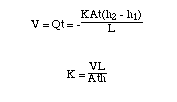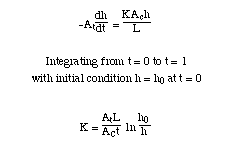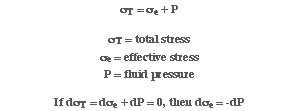Properties
of Aquifers
Physical Properties
Density of Fluid
- mass per unit volume (e.g., kg/m3 or g/cm3).
Dynamic Viscosity of
Fluid - resistance to relative flow of a Newtonian fluid (Pa-s or poise
(g/s-cm))
Bulk Modulus - Proportionality
constant between density and pressure. Inverse of compressibility (Pa or
lb/ft2)
Porosity of Earth
Materials
Porosity =
percentage of rock or soil that is void of solid material.
Effective Porosity = porosity available for fluid
flow (interconnected and large enough pore throats)
Porosity depends on packing of grains (cubic or rhombohedral),
grain size distribution (sorting), and shape of grains.
Specific Yield = ratio
of the volume of water that drains from a saturated rock owing to the attraction
of gravity to the total volume of the rock.
Specific Retention =
ratio of the volume of water a rock can retain against gravity drainage
to the total volume of the rock.
n = Sy + Sr
Maximum specific yield occurs in medium to coarse
sand size sediments.
Hydraulic Conductivity
of Earth Materials
Darcy's
Experiment - rate of water flow through a sediment sample
is proportional to the difference in height of the water between the two
ends and inversely proportional to the length of the flow path. The quantity
of flow is proportional to the hydraulic conductivity.

Q = discharge
K = hydraulic conductivity
A = Area
L = Length
h = hydraulic head
Hydraulic Conductivity
(m/s or ft/day)

Hydraulic conductivity
is a function of both the porous medium and the fluid passing through it.
Intrinsic
Permeability (m2
or Darcy)

Where  is fluid density and
is fluid density and  is fluid dynamic viscosity. Fluid density and viscosity depend on temperature,
salinity and pressure.
is fluid dynamic viscosity. Fluid density and viscosity depend on temperature,
salinity and pressure.
Intrinsic Permeability
is representative of the porous medium alone. It depends on size of openings,
degree of interconnection, and amount of open space. Thus, permeability
depends on grain size and sorting. Coarse grained and well-sorted sediments
have higher permeabilities.
Measuring Hydraulic
Conductivity
Constant
Head Permeameter

Falling Head
Permeameter (measuring low permeability sediments)

Water Table
Water table is the undulating
surface at which pore pressure is equal to atmospheric pressure.
A sloping water table indicates ground water is flowing
Ground water discharge occurs in topographic low
spots
Water table has same general shape as surface topography
Ground water general flows away from topographical
high spots and toward topographic lows.
Aquifers
Aquifer - a
geologic unit that can store and transmit water at rates fast enough to
supply reasonable amounts to wells (e.g., unconsolidated sands and gravels,
sandstones, limestones and dolomites, basalt flows, and fractured igneous
and metamorphic rocks).
Confining Layer - a
geologic unit having little or no intrinsic permeability (less than 10
md). Salt, shales and unfractured igneous and metamorphic rocks.
Unconfined Aquifer -
connected to the surface (meteoric recharge)
Confined Aquifer - overlain
by a confining layer. Limited or no direct access to recharge from surface.
Potentiometric surface of a confined aquifer may be above the land surface
(i.e, an artesian well).
Aquifer Characteristic
Transmissivity
(m2/s) - saturated
thickness times hydraulic conductivity
T = bK
where b = saturated thickness of aquifer
Specific Storage
(m-1) -
amount of water per unit volume stored or released from aquifer per unit
change in head.

Storativity
- volume of water that an aquifer will absorb or expel from storage per
unit surface area per unit change in head.
S = bSs (confined aquifer) or S = Sy
+ hSs (unconfined aquifer)
where Sy = specific yield
Effective
Stress - stress
supported by aquifer skeleton

Thus if fluid pressure decrease, effective stress
increases and the aquifer may compact
Compressibility
(m2/N) - coefficient
relating stress (pressure) to strain (change in aquifer thickness)

where db = change in aquifer thickness

![]()

![]() is fluid density and
is fluid density and ![]() is fluid dynamic viscosity. Fluid density and viscosity depend on temperature,
salinity and pressure.
is fluid dynamic viscosity. Fluid density and viscosity depend on temperature,
salinity and pressure.




